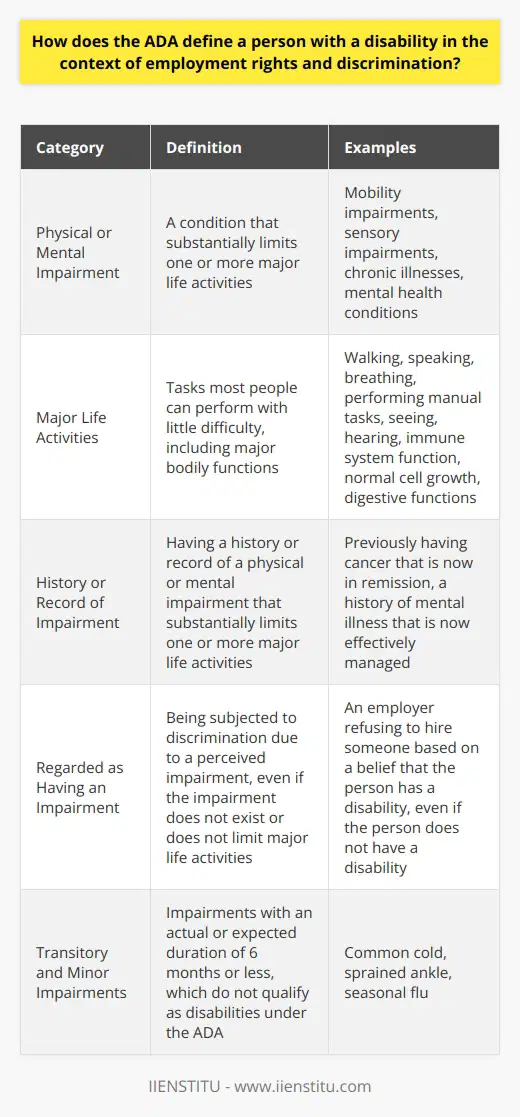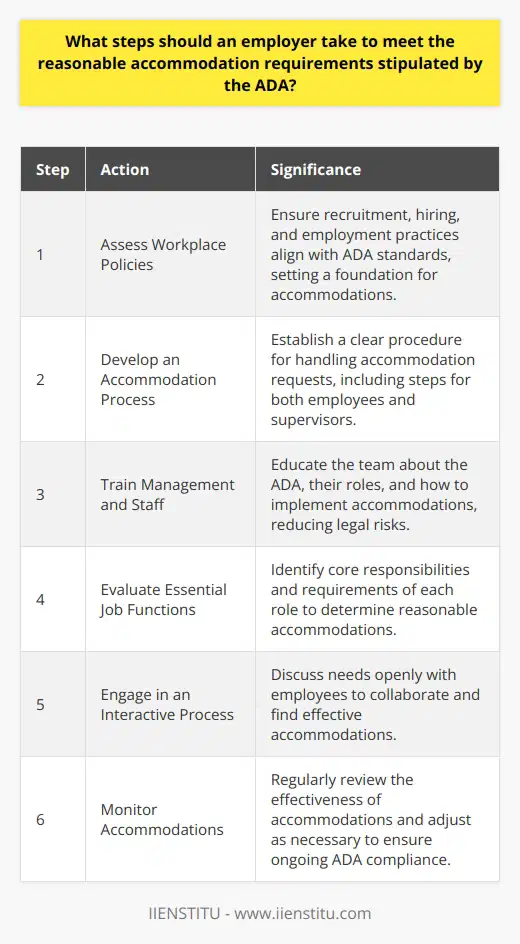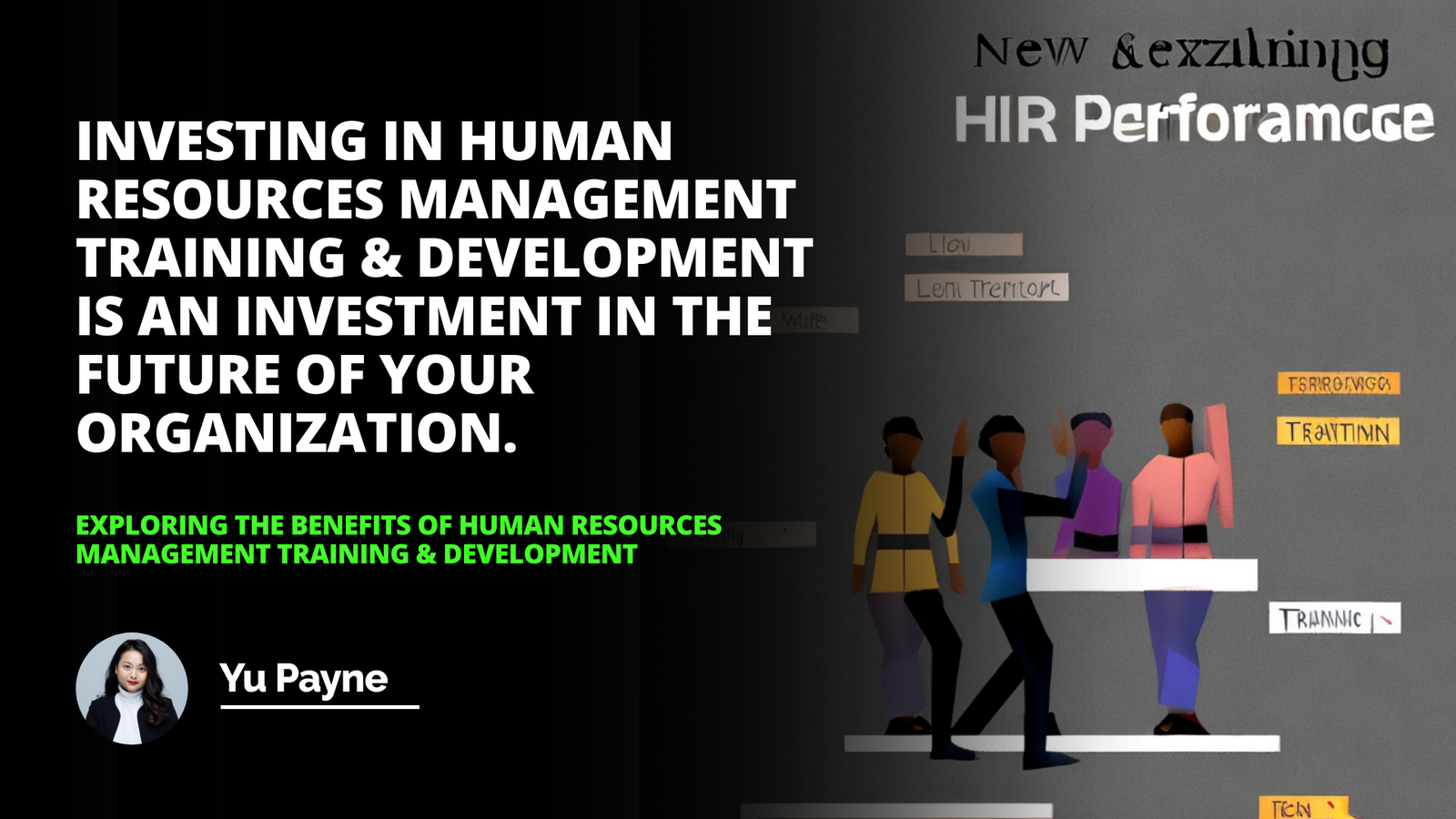
Navigating the legal landscape as an employer can be complex, especially when it comes to ensuring an inclusive workplace for individuals with disabilities. The Americans with Disabilities Act (ADA) plays a critical role in this process. For those who may be unfamiliar, the ADA was established in 1990 and is designed to protect the rights of individuals with disabilities, ensuring they have equal access to employment, public services, transportation, and more. This guide aims to break down the ADA’s requirements for employers, helping you understand what it means to be compliant while fostering an inclusive and supportive work environment.
Understanding the Basics of the ADA
The ADA is a wide-reaching civil rights law that prohibits discrimination against individuals with disabilities in all areas of public life, including jobs, schools, transportation, and public and private places open to the general public. It ensures that people with disabilities have the same rights and opportunities as everyone else. For employers, this law is especially relevant in terms of hiring practices, workplace accommodations, and creating an environment where all employees can thrive.
Who is covered under the ADA? The ADA applies to employers with 15 or more employees, and it covers both physical and mental impairments that substantially limit one or more major life activities. This means it encompasses conditions ranging from mobility impairments and visual or hearing impairments to chronic illnesses, mental health disorders, and more.
Why the ADA Matters to Employers
As an employer, understanding the ADA isn’t just about legal compliance—it’s about embracing a culture of inclusivity. Think about a time when you might have had a team member who required special accommodations to perform their role effectively. I remember working with a colleague who had a visual impairment; by providing him with a screen reader, not only did it make his work possible, but it also reinforced our commitment to an inclusive workspace. These experiences underscore the importance of seeing beyond the compliance aspect and recognizing the value each individual brings to the table.
Compliance with the ADA can also help employers avoid potential lawsuits. For instance, the U.S. Equal Employment Opportunity Commission (EEOC) enforces the ADA’s employment provisions, and non-compliance can lead to costly legal battles. Beyond avoiding legal issues, meeting ADA standards can improve overall employee morale, boost productivity, and enhance the reputation of your business as a fair and inclusive employer.
Key Responsibilities of Employers under the ADA
Navigating the ADA involves understanding its main components and implementing them in daily practices. Below are the primary responsibilities of employers:
1. Non-Discriminatory Hiring Practices
One of the core requirements of the ADA is to ensure that hiring practices do not discriminate against applicants with disabilities. This means that during job postings, interviews, and other selection procedures, employers must:
Focus on the applicant’s qualifications and their ability to perform the essential functions of the job, rather than their disability.
Avoid questions that directly relate to a candidate's medical history or disability status during the hiring process.
Offer reasonable accommodations during the interview, such as providing a sign language interpreter or ensuring that the interview location is accessible.
For example, consider a company looking to hire a new customer service representative. If an applicant with a mobility impairment applies, the employer cannot reject their application solely based on their inability to physically access the building. Instead, the focus should be on the candidate’s experience and ability to handle customer service tasks, and accommodations should be offered to enable their participation.
2. Providing Reasonable Accommodations
Reasonable accommodations are modifications or adjustments to a job, the work environment, or the way things are usually done during the hiring process. Employers are required to provide such accommodations unless doing so would cause an undue hardship—a term that refers to significant difficulty or expense relative to the employer’s size, resources, and operations.
Some examples of reasonable accommodations include:
Adjusting work schedules to allow for medical appointments.
Providing assistive technology, such as screen readers or voice recognition software.
Modifying workstations to accommodate wheelchairs or other mobility devices.
Allowing remote work arrangements where possible.
I once encountered a situation where a colleague needed to take time off for weekly physical therapy sessions. By adjusting their work hours slightly, we were able to maintain productivity while supporting their medical needs. It wasn't a huge adjustment on our end, but it made a world of difference for them. This is the essence of providing accommodations—small changes that can have a big impact.
3. Ensuring a Harassment-Free Environment
A critical aspect of ADA compliance is creating a work environment that is free from harassment based on disability. Employers must ensure that employees are protected against inappropriate comments, behaviors, or practices that target someone’s disability. This includes implementing and enforcing a zero-tolerance policy towards harassment, providing training for all staff, and establishing a clear process for reporting and addressing complaints.
For example, if an employee with a hearing impairment is subject to insensitive remarks about their use of assistive devices, the employer must address this behavior immediately. Failure to do so could not only violate the ADA but also damage the organization’s culture and reputation.
Practical Steps to Become ADA-Compliant
Navigating ADA compliance may feel daunting, but breaking it down into actionable steps can make the process manageable. Here are some practical steps you can take to ensure ADA compliance:
1. Conduct an Accessibility Audit
An accessibility audit helps identify areas where your workplace might not meet ADA standards. This audit could include assessing the physical accessibility of your building, reviewing your job postings for inclusive language, and ensuring that your online application process is accessible to individuals with disabilities.
2. Create a Clear Accommodation Request Process
Employees should know how to request accommodations and feel comfortable doing so. Make sure your HR policies clearly outline the process for requesting accommodations, and train managers on how to handle these requests. This transparency can prevent misunderstandings and foster a more supportive environment.
3. Invest in Staff Training
Staff training is crucial for building a disability-friendly workplace. Educate your team on ADA requirements, focusing on fostering a culture of respect and understanding. Training should cover topics like implicit bias, disability etiquette, and how to communicate effectively with colleagues who may have different needs.
4. Update Job Descriptions
Make sure your job descriptions emphasize the essential functions of each position rather than listing all physical requirements. This can help clarify what is truly necessary for the role and can guide you in determining whether a candidate with a disability can fulfill the role with or without reasonable accommodations.
Common Misconceptions About the ADA
Misunderstandings about the ADA can lead to mistakes that are costly for employers. Here are some of the most common misconceptions:
Misconception 1: “The ADA only covers physical disabilities.” In reality, the ADA covers a broad range of physical, mental, and emotional disabilities, including conditions like depression, anxiety, and learning disabilities.
Misconception 2: “Reasonable accommodations are always expensive.” Many accommodations are low-cost or even free, like adjusting a work schedule or allowing telecommuting.
Misconception 3: “If I hire someone with a disability, I can’t terminate them if things don’t work out.” The ADA does not guarantee job security if the employee is unable to perform essential job functions, even with reasonable accommodations. It simply ensures fair treatment.
Embracing Inclusion for a Better Workplace
The Americans with Disabilities Act (ADA) is more than just a legal obligation for employers—it's an opportunity to create a more inclusive and diverse work environment. By understanding the ADA’s requirements, you can build a workplace where all employees feel valued and empowered. Remember, providing reasonable accommodations and fostering an atmosphere of respect isn't just good practice—it’s about treating people with dignity. In the long run, these efforts pay off through improved employee morale, a broader pool of talent, and a stronger organizational culture.
Whether you're a small business owner or managing a large team, I encourage you to take a closer look at your current policies and consider how they can be improved to better align with the principles of the ADA. And remember, you don’t have to navigate this journey alone. There are numerous resources available to help you better understand and implement ADA requirements.
References
U.S. Equal Employment Opportunity Commission (EEOC) website: https://www.eeoc.gov
Job Accommodation Network (JAN): https://askjan.org
"Disability Law Handbook" by Jacquie Brennan
ADA National Network: https://adata.org
U.S. Department of Justice: https://www.ada.gov
Frequently Asked Questions
What are the key features of the Americans with Disabilities Act (ADA) that employers should be familiar with?
Understanding the Americans with Disabilities Act (ADA)
The ADA stands as a landmark civil rights law. It prohibits discrimination against individuals with disabilities. This is critical for employers to understand and comply with. The Act covers several key areas including employment, public accommodations, government services, and telecommunications. Here, we focus on employment.
Title I: Employment
Title I of the ADA deals with employment discrimination. It applies to employers with 15 or more employees. These employers must provide equal opportunities to qualified individuals with disabilities.
- Non-Discrimination: Employers cannot discriminate in job application procedures, hiring, advancement, or discharge of employees based on disability.
- Reasonable Accommodation: Employers must provide accommodations to employees with disabilities unless it causes undue hardship.
- Qualification Standards: Employers may not set standards that screen out or tend to screen out individuals with disabilities.
Accessibility in Communication
Effective communication with employees who have disabilities is essential. Employers must ensure that they are as clear and comprehensible as possible when conversing with disabled employees.
- Accessible Formats: Employers might need to provide information in accessible formats.
- Assistive Technologies: Employers should be ready to use technologies that aid in communication.
Medical Examinations and Inquiries
The ADA sets strict guidelines on medical examinations and inquiries about an employee's disability.
- Pre-Employment Inquiries: Generally prohibited before a job offer.
- Medical Examinations: Permitted post-offer as long as this is standard for all new employees.
- Disability Inquiries: Allowed only if job-related and consistent with business necessity.
Retaliation and Coercion
The ADA clearly forbids retaliation against individuals for asserting their rights under the act.
- Retaliation: Employers may not retaliate against an individual for filing a disability discrimination complaint.
- Coercion: It is illegal to coerce, intimidate, threaten, or interfere with ADA rights.
ADA Compliance and Enforcement
Compliance with the ADA is not just ethical, but a legal imperative.
- Training: Providing thorough ADA training to HR and management is crucial.
- Policies and Procedures: Implement comprehensive policies and procedures to ensure ADA compliance.
Conclusion
Employers must familiarize themselves with these ADA features to create inclusive workplaces. Understanding and implementing the ADA strengthens not just legal compliance but also workplace morale and diversity. Employers embracing the ADA's principles benefit from a broader pool of talent and a positive workplace environment.

How does the ADA define a person with a disability in the context of employment rights and discrimination?
Understanding the ADA's Definition of Disability
The Americans with Disabilities Act (ADA) is a landmark civil rights law. It prohibits discrimination against individuals with disabilities. This includes areas like employment, transportation, and public accommodations. Under the ADA, employers cannot treat qualified individuals with disabilities unfairly. The term "qualified" refers to those who can perform essential job functions. They may do so with or without reasonable accommodations.
Who Qualifies as Disabled Under the ADA?
The ADA's definition of disability is technical. It is also broad to ensure inclusive protection. The law categorizes disability in three main areas.
- A physical or mental impairment exists.
- The impairment substantially limits one or more major life activities.
- A person has a history or record of such an impairment.
Moreover, the ADA also protects individuals who do not have a disability. But, they might face discrimination due to a relationship or association with someone who has a disability.
Major Life Activities
Major life activities include tasks most people can perform with little difficulty. Here are some examples:
- Walking
- Speaking
- Breathing
- Performing manual tasks
- Seeing
- Hearing
Furthermore, the ADA Amendments Act of 2008 expanded these categories. The act included major bodily functions. These cover functions like immune system, normal cell growth, and digestive functions.
Impairment That Is Not Transitory and Minor
Not every impairment qualifies as a disability under the ADA. The impairment must not be transitory and minor. A transitory impairment has an actual or expected duration of 6 months or less.
Reasonable Accommodation
Employers must provide reasonable accommodations. This is crucial for a qualified individual to perform the job. Reasonable accommodations vary. For example, they might include:
- Making existing facilities accessible
- Job restructuring
- Modified work schedules
- Acquiring or modifying equipment
However, an employer does not have to provide accommodations. This stands if doing so would cause undue hardship. Undue hardship means significant difficulty or expense. Courts consider various factors when assessing undue hardship. These can include:
- The nature and cost of the accommodation
- The overall financial resources of the facility
- The number of persons employed at the facility
- The effect on expenses and resources
Protection from Discrimination
The ADA ensures equal employment opportunities. It forbids discrimination in job application procedures, hiring, advancement, and discharge. It also covers other terms, conditions, and privileges of employment.
The Equal Employment Opportunity Commission (EEOC) enforces ADA's employment provisions. It also issues regulations and guidance on these matters.
Understanding the ADA's disability definition helps foster a more inclusive workplace. It ensures fair treatment for all employees. This holds crucial for building diverse and positive work environments.

What steps should an employer take to meet the reasonable accommodation requirements stipulated by the ADA?
Understanding ADA Accommodations
The Americans with Disabilities Act (ADA) mandates reasonable accommodations. Employers must ensure equal employment opportunities. This applies to individuals with disabilities. Familiarity with the ADA is crucial.
Assess Workplace Policies
First, review internal policies. Examine recruitment, hiring, and employment practices. Ensure they reflect ADA standards. This sets a foundation for accommodation.
Develop an Accommodation Process
It is essential to establish a procedure. This should address how to handle accommodation requests. Include clear steps for both employees and supervisors.
Training Management and Staff
Educate your team about the ADA. Staff should understand their roles. They should know how to implement accommodations. Training can reduce legal risks.
Communicate Openly with Employees
Encourage dialogue about accommodations. Create an environment where employees feel comfortable. They should share requests without fear of stigma.
Evaluate the Essential Job Functions
Identify the job's core responsibilities. Understand what each role requires. This helps determine reasonable accommodations.
Consider Various Accommodation Options
Many accommodations exist. Examples include modified schedules and equipment. Tailor solutions to individual needs.
Engage in an Interactive Process
Interaction is necessary. Discuss needs openly with the employee. This collaboration ensures finding effective accommodations.
Document All Actions
Keep detailed records. Document requests, discussions, and decisions. This protects both the employee and the employer.
Monitor Accommodations
Regularly review the effectiveness of accommodations. Adjust them as necessary. This ensures ongoing compliance with ADA.
Stay Informed
Finally, stay updated on ADA regulations. They can change. Employers must adapt their practices accordingly.



